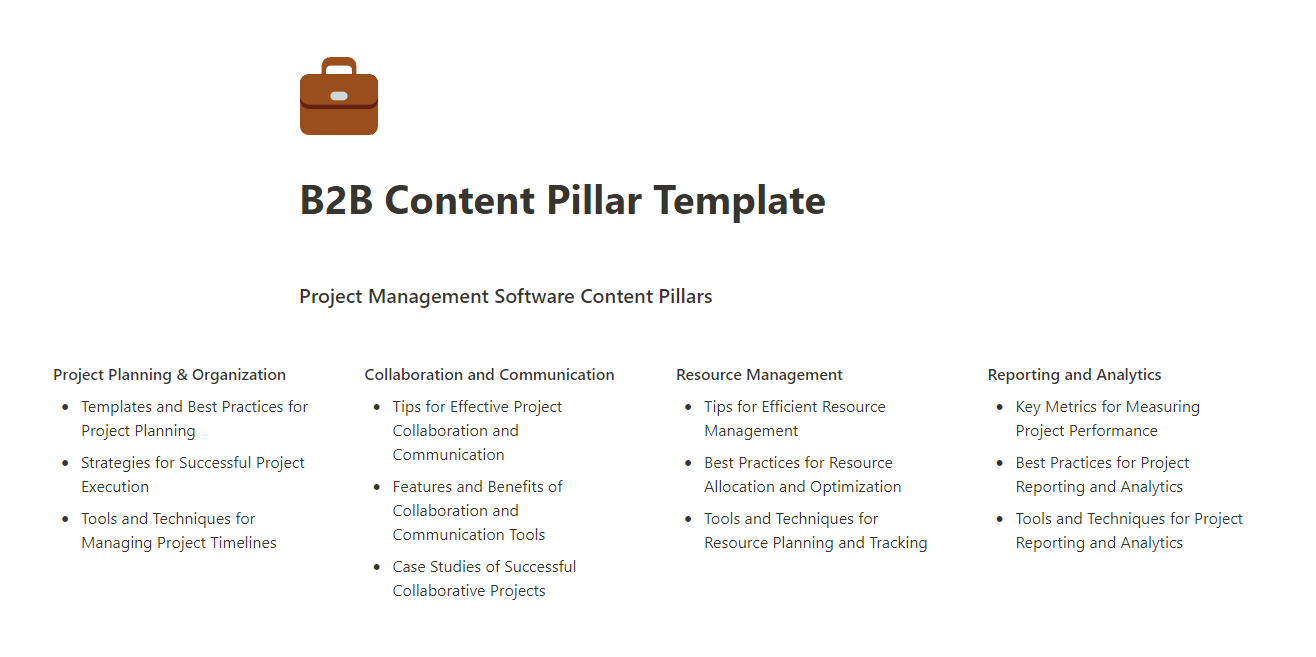Picture this: you are in the middle of creating content for your website or blog, and you are feeling overwhelmed by the sheer volume of topics you need to cover. You have a few great ideas, but still struggling to tie them all together into a cohesive and strategic plan. That’s where content pillars come in.
Think of content pillars as the foundation of your content marketing strategy. They are the overarching themes or topics that your content revolves around, and they provide a framework for all of the individual pieces you create. With a robust set of content pillars in place, you can ensure that your content is always on-brand, relevant to your audience, and strategically aligned with your business goals.
But how do you identify your content pillars? And what does a content pillar even look like? In this post, we are going to dive into the world of content pillars, exploring what they are, why they matter, and how to identify your own. We will also look at content pillar examples and a content pillar template to get you started.
Table of Contents
What Are Content Pillars?
Content pillars are the foundation of any successful B2B content marketing strategy. They are the overarching themes or topics that your content is centered around. Think of them as the pillars that support your entire content marketing structure. According to HubSpot, these pillar pages should be around 4000 words.
These pillars are important because they help you stay focused on your core message and provide a framework for all of your individual pieces of content. By identifying your content pillars, you can ensure that your content is always on-brand, relevant to your audience, and aligned with your business goals.
Content Pillar Examples For B2B Companies
Let’s take a look at some content pillar examples to help illustrate this concept. If you are a B2B software company, your content pillars might include topics like:
- Product education: This pillar might include content that explains how your product works, the features and benefits, and how it can solve your customers’ pain points.
- Thought leadership: This pillar might include content that explores industry trends, insights, and opinions. By establishing your brand as a thought leader in your industry, you can position yourself as a trusted authority and build trust with your audience.
- Customer success stories: This pillar might include case studies or testimonials from satisfied customers. These stories can help show the value of your product and inspire others to consider your solution.
By focusing on these core content pillars, you can ensure that all of your content is aligned with your brand and messaging. Also, you can build a library of content that supports each pillar, creating a cohesive and consistent content marketing strategy.
Here’s what an organized content pillar would look like:
4 Tips On How To Identify Content Pillars
Now that we understand what content pillars are and why they are important, let’s dive into how to identify your own. This process can seem daunting, but with the right steps, you can quickly identify your core content pillars and build a successful B2B content marketing strategy.
Step 1: Define Your Business Goals
The first step in identifying your content pillars is to define your business goals. What are the key objectives you want to achieve with your content marketing strategy? These goals will help guide your content pillar selection.
For example, your business goal is to increase sales. In that case, your content pillars might focus on educating your audience about your product or service, demonstrating its value, and sharing customer success stories.
Step 2: Understand Your Target Audience
The second step is to understand your target audience. Who are you trying to reach with your content? What are their pain points and challenges?
By understanding your target audience, you can identify the topics and themes that are most relevant to them. This will help you create content that resonates with your audience and positions your brand as a trusted solution to their problems.
Step 3: Brainstorm Pillar Topics
Once you have defined your business goals and understood your target audience, it is time to brainstorm your content pillar topics. These are the core themes or topics that your content should focus on.
Start by listing out all the topics that apply to your business and your audience. Then, group these topics into broader themes or categories. These categories will become your content pillars.
Step 4: Refine Your List
After you have brainstormed your content pillars, it is time to refine your list. Narrow down your list to 3-5 core content pillars that will guide your content strategy.
Consider factors like relevance to your audience, alignment with your business goals, and the level of expertise and authority you have in each pillar. Focus on the pillars that are most important to your business and have the most potential to drive results.
Follow these steps to identify your content pillars and build a successful B2B content marketing strategy. Remember, content pillars are the foundation of your content marketing structure, so take the time to get them right and you will set yourself up for success.
Content pillar template for B2B companies
Here’s a detailed content pillar template for B2B businesses:
Industry Trends and Insights
This content pillar should focus on exploring industry trends and providing valuable insights to your audience. You can cover topics like emerging technologies, regulatory changes, and market trends. This pillar will establish your brand as a thought leader in your industry and position you as a trusted authority.
Product Education and Features
This content pillar should focus on educating your audience about your product or service. You can create content that explains how your product works, its features and benefits, and how it can solve your customers’ pain points. This pillar will help you build awareness and consideration for your solution.
Customer Success Stories and Testimonials
This content pillar should focus on sharing customer success stories and testimonials. You can create case studies, interviews, or video testimonials that highlight how your solution has helped your customers achieve their goals. This pillar will help you build trust with your audience and highlight the value of your solution.
How-To Guides and Tutorials
This content pillar should focus on providing actionable advice and guidance to your audience. You can create how-to guides, tutorials, and other educational content that helps your audience solve their challenges. This pillar will position your brand as a helpful resource and establish you as a trusted advisor.
Industry Research and Data
This content pillar should focus on sharing industry research and data. You can create whitepapers, reports, and other content that provides valuable insights and data-driven recommendations to your audience. This pillar will help you establish credibility and authority in your industry.
Here’s a sample content pillar template for B2B companies:

Next steps after creating content pillars
Once you have identified your content pillars, there are several next steps you can take to build a successful B2B content marketing strategy.
Develop a Content Calendar
Create a content calendar that outlines the topics and themes you’ll be covering under each pillar. This will help you stay organized and consistent with your content creation.
Conduct Keyword Research
Conduct keyword research for each content pillar to identify the specific terms and phrases your audience is searching for. This will help you optimize your content for search engines and increase visibility.
Plan Your Content Types
Determine the types of content you’ll be creating under each pillar, such as blog posts, videos, infographics, or eBooks. Consider the preferences of your target audience and the format that will best showcase your expertise.
Assign Responsibility
Determine who will create and manage content for each content pillar. This can include in-house team members, freelance writers, a content marketing agency, or a SaaS link building agency.
Establish Performance Metrics
Identify key performance metrics for each content pillar, such as website traffic, lead generation, or social media engagement. This will help you measure the success of your content marketing strategy and make data-driven decisions for future content creation.
Remember to evaluate and refine your strategy frequently based on performance metrics and audience feedback to ensure continued success.
Start creating impressive content pillars
Content pillars are a powerful tool for building a successful B2B content marketing strategy. By identifying your core themes and aligning them with your business goals and target audience, you can create a cohesive and effective content strategy that drives results.
Remember, the key to success is to create high-quality, relevant, and engaging content that provides value to your audience. Use your content pillars as a foundation for creating a variety of content types, such as blog posts, videos, infographics, eBooks, and more.
By taking a strategic approach to content creation and aligning your efforts with your business goals, you can establish your brand as a thought leader in your industry, build trust with your audience, and drive meaningful results for your business.
So, start identifying your content pillars today and take the next steps to build a comprehensive content marketing strategy that delivers real results for your B2B business!
Looking for someone to write stellar content for your pillar pages? Contact me!
Related Posts
March 18, 2024
Technical SEO Audit: A 6-Step Guide to Improving Website Performance
0 Comments9 Minutes



